Research Overview
The Consortium is focused on active seismology techniques. The seismic bandwidth is characterized as the useful frequency range of measured backscatter response of the earth due to a seismic source at or near the earth’s surface. Solutions for both land and marine environments are being developed by the Consortium research program.
Current Projects
CREMV-XP: Counter Rotating Eccentric Mass Actuator
A low-frequency strong-force actuator needed to provide large forces at low frequencies with applications for both land and marine seismic exploration.
Forces to 400 kilo-Newtons at Low Frequencies including One Hertz:
Applications for Land and Marine Seismic Sources
The Technology Concept
- Commercial seismic vibrators are displacement-limited, resulting in force output fall-off with frequency-squared. The force output at low frequencies is weak.
- The counter rotating eccentric mass (CREM) actuator displacements are far greater, enabling large forces at low frequencies.

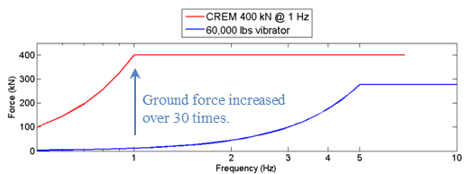
Research & Development Status
- A small-scale CREM actuator has been demonstrated and successfully coupled frequencies down to one hertz into the ground.
- A full-scale experimental prototype (CREMV-XP) that can generate controlled sweeps with 400 kN of ground force from one to six hertz has been designed and fabricated.
- An experimental program has been designed and is being prepared for implementation.
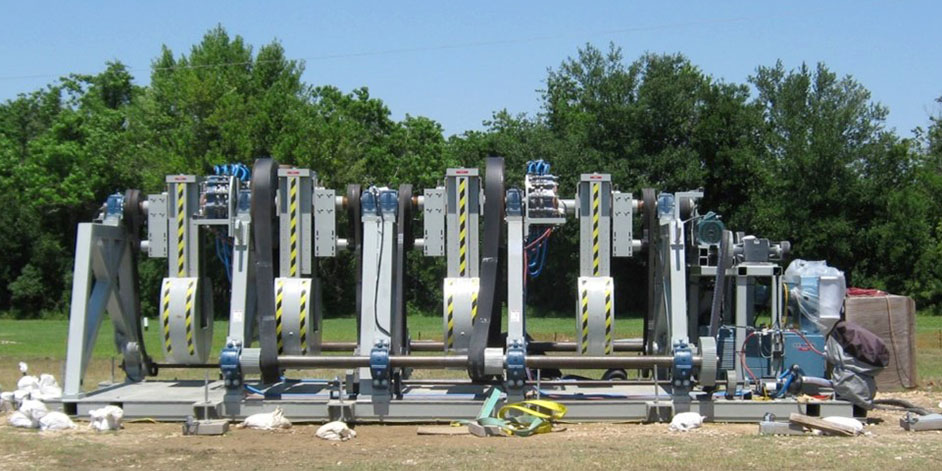

Research & Development Plans
- Characterize the actuator and establish performance capabilities.
- Measure the earth response and quantitatively determine signal-to-noise ratios in the operational frequency band.
- Determine source performance needed to measure back-scatter down to one hertz.
- Develop specifications for a low frequency commercial prototype CREM seismic source.
Patents & Publications
- Patent US 9,310,499 (Europe: 3,033,638): Low frequency seismic acquisition using a counter rotating eccentric mass vibrator, Meier, Heiney, Tomic, Ibanez, Byrne, April 12, 2016.
Marine Dipole Seismic Source
A shallow-tow marine seismic source with constructive ghosting at low frequencies.
Constructive Source Ghosting at Low Frequencies:
Applications for Low Frequency Marine Seismic Sources and Source De-Ghosting
The Technology Concept
- Commercial marine seismic sources (e.g., airguns, marine vibrators) drive volumetric changes to excite seismic waves in a fluid medium. Their ghosting characteristics notch out the low frequencies.
- The marine dipole seismic source excites seismic waves by oscillating a fixed volume in the vertical direction. It’s ghosting characteristic passes low frequencies.

Research & Development Status
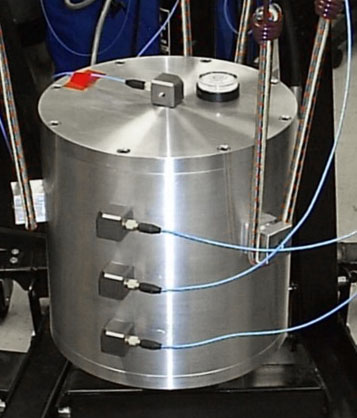
- From physical acoustics and fluid dynamics, theory was formulated to predict the dynamical behavior and radiated acoustic field for an oscillating rigid volume.
- A small scale, higher frequency marine dipole source has been demonstrated. The measured source behavior and wavefield characteristics agreed with predictions.
- Confirmed far field radiation amplitudes at wavelengths orders larger than the rigid volume dimension,
- Confirmed wavefields radiated on opposite sides of the source were opposite polarity from one another.
- From theory, the requirements for an experimental dipole marine source prototype capable of far-field radiation at low frequencies, including one hertz, have been predicted.
- An experimental marine dipole seismic source for low frequency radiation requires a large force, low frequency actuator, such as the CREM actuator (see Counter Rotating Eccentric Mass Actuator).
Research & Development Plans
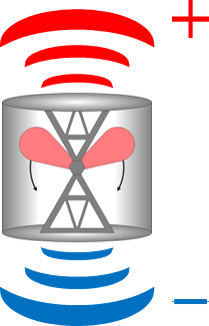
- Design and build an experimental dipole seismic source prototype to demonstrate far field radiation in a marine environment at frequencies substantially below current technologies.
- Characterize experimental source performance and far-field radiation. Compare measurements with predictions. Quantify far-field signal-to-noise ratios in the operational frequency band.
- Develop specifications for a low frequency commercial prototype marine dipole source.
Patents & Publications
- Patent US 7,377,357: Marine seismic acquisition method and apparatus, Duren and Meier, May 27, 2008.
- Patent US 8,833,509 (Australia: 2,012,254,102; Canada: Patent 2,832,723): Two-component source seismic acquisition and source de-ghosting, Meier and Duren, September 16, 2014.
- Meier and Duren, “Theory for a low frequency marine dipole seismic source,” Journal of Seismic Exploration, 25, pp. 285-298, June 2016.
Pressure Gradient Transducer
A transducer measuring pressure gradient, the Green’s Theorem complement to pressure measurements.
A Motion Insensitive Transducer for Measuring Pressure Gradient in a Fluid Medium:
Applications for Marine Seismic Acquisition
The Technology Concept
- Commercial multicomponent streamers use motion sensors. Measurements are assumed to represent the particle velocity (a proxy for pressure gradient) of passing seismic waves. However, many motions in fluid and streamers, not related to seismic waves, contaminate the measurement. Error overwhelms the measurement at frequencies near and below 20 hertz.
- Our pressure gradient transducer is insensitive to motion, and measures the pressure gradient in a fluid medium directly.
- The energy band gap in some materials is sensitive to pressure.
- A gradient in pressure causes a gradient in the energy band gap; causing a gradient in free charge carriers, which can be exploited for an electrical response and transducer effect.

Research & Development Status
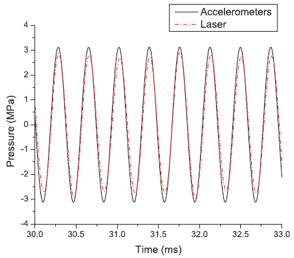

- Semiconductor and solid state plasma theory was used to determine the plausibility of a measurable response from seismic waves with frequencies down to one hertz and amplitudes down to SS0 noise floor.
- An experimental program to verify the transducer effect was designed and implemented. High frequencies and large signals are used to simplify verification.
- A laser diagnostic has been developed to independently measure the free charge carrier concentration in our preferred semiconductor material.
- Bulk pressure modulations were excited in a semiconductor sample and corresponding dynamics in free charge carrier population were observed using a laser diagnostic.
- Pressure gradient modulations were excited in an acoustically resonant semiconductor sample with length equal to one wavelength, and corresponding dynamics in pressure and pressure gradient were confirmed using the laser diagnostic.
- Magnetic field apparatus was fabricated to test for diamagnetic current from transducer effect. The pressure gradient transducer effect was experimentally verified
Research & Development Plans
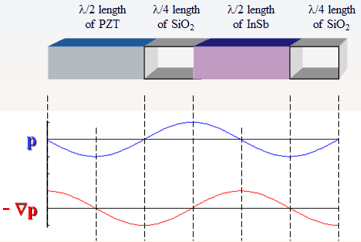
- Design experiments to verify diffusion current from transducer effect.
- Proceed with engineering-research phase to confirm fluid coupling, and that the sensitivities, dynamic range, and other characteristics needed for seismic applications are achievable.
- Package the transducer and manufacture sufficient count to instrument a streamer section for field trials.
- Develop specifications for a full streamer commercial prototype.
Patents & Publications

- Patent US 7,295,494: Diamagnetic current response transducer for sensing pressure gradient in a fluid medium, Meier, November 13, 2007.
- Patent US 8,681,586 (Australia: 2,009,318,026; Canada: 2,744,446; Europe: 235,665; Israel: 212,294; South Korea: 101,648,730; Taiwan: 499,758): Free charge carrier diffusion response transducer for sensing gradients, Hallock and Meier, March 25, 2014.
- Hallock and Meier, “Low frequency pressure modulation of indium antimonide,” Rev. Sci. Instrum. 83, 073906 (2012); doi.org/10.1063/1.4737142.
- Hallock and Meier, “Density modulation of a solid-state plasma using acoustic pressure,” IEEE Pulsed Power & Plasma Science Conference Proceedings, 2013.
- Hallock and Meier, “Resonant transducers for solid-state plasma density modulation,” Rev. Sci. Instrum. 87, 044902 (2016); doi.org/10.1063/1.4947507.
- Hallock and Meier, “Diamagnetic current measurements in a solid-state plasma,” Rev. Sci. Instrum. 89, 083505 (2018); doi.org/10.1063/1.5029356.
- H. Salehi Najafabadi, “Carrier Transport Response and Behavior of Semiconductors Having a Gradational Energy Band Gap Due to Gradients in Pressure or Other Physical Properties,” Ph. D. Dissertation (2020), University of Houston.
- H. S. Najafabadi, M. A. Meier and G. A. Hallock, “Electromagnetic Response from Acoustic Resonance in Indium Antimonide,” 2021 International Conference on Electromagnetics in Advanced Applications (ICEAA), 2021, pp. 372-372. doi.org/10.1109/ICEAA52647.2021.9539656.
- H. S. Najafabadi, M. A. Meier and G. A. Hallock, “The Effect of Temperature on the Electrical Response Excited by Acoustically Driven Bandgap Modulation in an Indium Antimonide Transducer,” 2021 International Semiconductor Conference (CAS), 2021, pp. 287-290. doi.org/10.1109/CAS52836.2021.9604197.
- Hasan Salehi Najafabadi, Mark A. Meier, Gary A. Hallock, “Voltage and current excitation from acoustically stimulated band gap modulation in InSb,” APS March Meeting 2022, Y46-11, March 2022.
Low Frequency Seismic Imaging & Inversion
Seismic algorithms for low frequencies are required if high frequency and weak scattering assumptions are no longer valid for low frequencies.
Research is needed to determine how to make best use of data from the new low frequency bandwidth.
Useful processing products from reflection seismology measurements, such as seismic imaging and seismic inversion, are required to create subsurface mapping of structure and properties. Assumptions are necessary to make these problems tractable and sufficiently inexpensive to be useful. Contemporary methods rely heavily on many assumptions that many decades of practice have empirically shown to be reasonably effective for the conventional frequency band, but are not known to be valid or reasonable for low frequencies.
The Consortium examines the assumptions inherent in contemporary methods, and develops an understanding and determination of their efficacy for the low frequency band. Improved methods are developed to ensure utility of the full bandwidth made available by new acquisition techniques.
Using new experimental prototypes, the Consortium is able to design controlled experiments to collect useful experimental low frequency data for testing assumptions and algorithms.